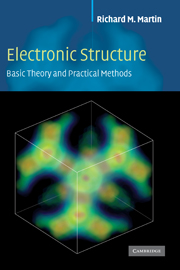Book contents
- Frontmatter
- Contents
- Preface
- Acknowledgments
- Notation
- Part I Overview and background topics
- Part II Density functional theory
- 6 Density functional theory: foundations
- 7 The Kohn–Sham auxiliary system
- 8 Functionals for exchange and correlation
- 9 Solving Kohn–Sham equations
- Part III Important preliminaries on atoms
- Part IV Determination of electronic structure: the three basic methods
- Part V Predicting properties of matter from electronic structure – recent developments
- Appendix A Functional equations
- Appendix B LSDA and GGA functionals
- Appendix C Adiabatic approximation
- Appendix D Response functions and Green's functions
- Appendix E Dielectric functions and optical properties
- Appendix F Coulomb interactions in extended systems
- Appendix G Stress from electronic structure
- Appendix H Energy and stress densities
- Appendix I Alternative force expressions
- Appendix J Scattering and phase shifts
- Appendix K Useful relations and formulas
- Appendix L Numerical methods
- Appendix M Iterative methods in electronic structure
- Appendix N Code for empirical pseudopotential and tight-binding
- Appendix O Units and conversion factors
- References
- Index
7 - The Kohn–Sham auxiliary system
from Part II - Density functional theory
Published online by Cambridge University Press: 05 June 2012
- Frontmatter
- Contents
- Preface
- Acknowledgments
- Notation
- Part I Overview and background topics
- Part II Density functional theory
- 6 Density functional theory: foundations
- 7 The Kohn–Sham auxiliary system
- 8 Functionals for exchange and correlation
- 9 Solving Kohn–Sham equations
- Part III Important preliminaries on atoms
- Part IV Determination of electronic structure: the three basic methods
- Part V Predicting properties of matter from electronic structure – recent developments
- Appendix A Functional equations
- Appendix B LSDA and GGA functionals
- Appendix C Adiabatic approximation
- Appendix D Response functions and Green's functions
- Appendix E Dielectric functions and optical properties
- Appendix F Coulomb interactions in extended systems
- Appendix G Stress from electronic structure
- Appendix H Energy and stress densities
- Appendix I Alternative force expressions
- Appendix J Scattering and phase shifts
- Appendix K Useful relations and formulas
- Appendix L Numerical methods
- Appendix M Iterative methods in electronic structure
- Appendix N Code for empirical pseudopotential and tight-binding
- Appendix O Units and conversion factors
- References
- Index
Summary
If you don't like the answer, change the question.
Summary
Density functional theory is the most widely used method today for electronic structure calculations because of the approach proposed by Kohn and Sham in 1965: to replace the original many-body problem by an auxiliary independent-particle problem. This is an ansatz that, in principle, leads to exact calculations of properties of many-body systems using independent-particle methods; in practice, it has made possible approximate formulations that have proved to be remarkably successful. As a self-consistent method, the Kohn–Sham approach involves independent particles but an interacting density, an appreciation of which clarifies the way the method is used. The present chapter is devoted to the basic formulation of the Kohn–Sham approach and the ideas behind the crucial ingredient, the exchange–correlation energy functional Exc[n]. Information on approximate functionals in widespread use is deferred to Ch. 8, and methods for solution of the Kohn–Sham equations using the functionals are the subjects of Ch. 9 and much of the remainder of this tome.
Replacing one problem with another
The Kohn–Sham approach is to replace the difficult interacting many-body system obeying the hamiltonian (3.1) with a different auxiliary system that can be solved more easily. Since there is no unique prescription for choosing the simpler auxiliary system, this is an ansatz that rephrases the issues. The ansatz of Kohn and Sham assumes that the ground state density of the original interacting system is equal to that of some chosen non-interacting system.
- Type
- Chapter
- Information
- Electronic StructureBasic Theory and Practical Methods, pp. 135 - 151Publisher: Cambridge University PressPrint publication year: 2004
- 1
- Cited by



